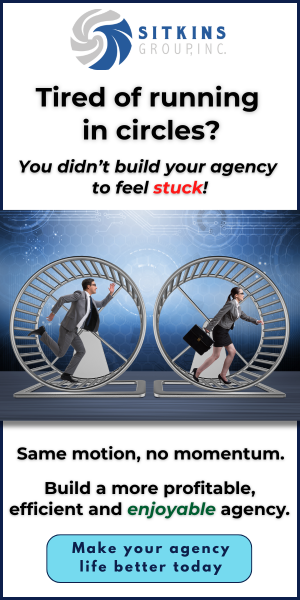The science behind a healthy sales pipeline
By Ryan Smith
Some say “sales is a numbers game.”
While it is to an extent, there’s a lot going on behind those numbers, and better understanding them can show you where to focus on improving.
You probably already track your sales and prospecting efforts, but let’s look at the Math of Sales: what to measure and how to use it to help you become a better seller.
Conversion rates
One of the most important measures to track is your conversion rate across different stages of the sales process. For each point of conversion, take the outcome you achieved and divide it by the number of actions it took you to get there.
The longer you collect data, the more accurate these will be, which will help you more accurately forecast what you need to do to accomplish your goals.
What I’ll show you can be applied to smaller stages if you really want to take this further but, to keep it simple, we’ll look at the conversion rates for three key stages:
- Prospect connect rate. To solve this, take the number of connected prospects who answered a call or clicked a link and divide it by the total number of prospects you reached out to.
The quality of your list—or when sending emails, the subject line and message—will be really important factors. The result is often between 5% and 20%, maybe higher if you have things dialed in or are working a great list. On the other hand, many people screen incoming phone calls and some lists might have bad data, so it’s not uncommon to see this number as low as 2% to 5%.
- Lead conversion rate. This can be found by taking the number of qualified leads, who are ready to explore your offering, and dividing it by the number of connected prospects.
You got their attention, but were they willing to keep talking? This will depend on your ability to get in front of the right prospects and also on your message. Many sellers will see it land between 10% and 20%.
- Deal close rate. To solve, take the number of won deals and divide by the number of qualified leads.
Once qualified leads are in the pipeline, how many come out the other end of the funnel? You can look more granularly at different steps in your sales process, but this rate will depend heavily on your sales skills and product fit. Assuming you’re getting the right product in front of the right people, a decent close rate can often be between 20% and 30%.
When using your deal close rate in the rest of this article, we will focus on outbound or Sales Qualified Leads (SQLs). You may want to measure your inbound or Marketing Qualified Leads (MQLs) separately, even though everything ends up attributing to your overall pipeline and close rates.
The reason for this is that most salespeople will not have much influence over the quality or quantity of MQLs, and the team in charge of marketing should be running similar calculations to assess their own Math of Sales.
Conversion multipliers
Once you know the rates above, reverse the math to work backward from your goal to make sure you stay on track.
For each, either flip the formula above or use the “inverse” button (1/x) on a calculator after you have your conversion rate. This gives you a “multiplier” that can tell you the level of activity necessary to hit a particular outcome.
Use this to ensure you plan for the activity necessary to hit your numbers and to make sure you set realistic goals. This will help you set Key Performance Indicators (KPIs), where the activity is a “lead measure” and the outcome is a “lag measure.” Lag measures usually are dependent on the lead measure, and good goal setting includes regular tracking of both.
Many people forget the lead measures; you have more influence on them and they drive the lag measures. Combine this with your sales goals, average deal size, and the average time it takes to close a deal to set your activity targets.
The Longer you collect data, the more accurate
[your numbers] will be, which will help you
more accurately forecast what you need to do
to accomplish your goals.
Math of sales in action
Here’s a quick example of how this may work:
You call 400 prospects over a week and get 50 on the phone (12.5% prospect connect rate). Those 50 conversations get you five meetings with qualified leads (10% lead conversion rate). Out of those five meetings, two eventually close (20% close rate).
Now, imagine you have a $500,000 annual quota and your average deal is $5,000. That means you need to close 100 deals.
Use the inverse of your stats to get your multiplier and set your activity goals:
100 closed deals based on a 20% close rate means you need to have a 5x pipeline, or 500 qualified leads
To get 500 leads, you would need to talk to 10x prospects (or 5,000, if only 10% convert to a deal)
And, based on a 12.5% connect rate, you need to call 8x prospects, so it’s probably going to take 40,000 individuals in your overall list.
In this scenario, some red flags come up because that means you need to be attempting to contact almost 800 people each week.
That’s nearly twice as much effort as the (on average!) sample week shared earlier. Plus, it’s always wise to pad your goals to make sure you aren’t just narrowly hitting your quota.
This means that something needs to change for you to realistically hit your numbers.
Improving your numbers
Depending on which rate you want to improve, there are a few things to consider based on your resources, strategies, and sales skills.
- Prospect connect rate. The ability to get your prospect’s attention may go beyond your ability to write a catchy subject line, and there’s no skill improvement that’s going to make a person pick up the phone. It’s really going to depend on your outreach methods and strategy.
First, make sure the data you are using is current and validated. Plenty of tools out there will verify information and some may be able to tell you the likelihood of getting through by phone.
Because everyone has different forms of communication they prefer, look at multi-channel outreach strategies by balancing your outbound with phone, email, and social media. For email and social media, make sure you have a strong subject with a hook that stands out from other messages to entice an open.
Be careful when using mass email to not harm your primary email domain. Overdo it and not only will prospects stop seeing your mail, but your established clients may not either. There is a science to high-volume email campaigns, so do your research on how to do it effectively and ensure email deliverability.

Similarly, for phone, make sure to rotate numbers to avoid being labeled as “potential spam.”
Don’t assume people will connect on the first try. It’s been shown that it may take eight or more attempts over time to get connected with someone.
Try tracking more granular data to better identify lead data sources (e.g., the method of connection when one is made or the number of attempts it took to finally connect). This will start to tell you where there’s room for improvement and where to double-down your attention.
2. Lead conversion rate. Success in converting leads starts with putting yourself in front of prospects who are likely to be interested in your offering. Carefully define an Ideal Client Profile (ICP) that can be used in selecting prospects, so you aren’t wasting time talking to the wrong people.
Ideally, you would know enough about your ICPs to make that first contact really count. These prospects should share common problems, pain points, and challenges that you can highlight to get interest in exploring solutions with you further.
For when that connection is made, make sure to have a strong opening script, and practice it to knock your cold calls out of the park. As for email and social media, the message needs to capture their attention and drive interest enough to respond.
To maximize your lead conversion rate, experiment with your scripts and templates to dial things in as you go. This includes tracking the objections you get and practicing ways to respond to them.
- Deal close rate. Improving your deal close rate is going to weigh more heavily on your sales skills and product fit. Again, assuming you are getting in front of your ICPs, the product fit should hopefully not be an issue. Start to analyze where deals exit the pipeline to see what stages tend to be the bigger hurdle for you.
If it’s early in the process, something may need to change in your initial engagements to keep the prospect moving through your sales funnel. It could be as simple as setting clear next steps or getting other stakeholders involved earlier in the conversation.
If you are losing deals further into the funnel, like potential clients disappearing after delivering a proposal or finding out that you are losing them to competitors, then different strategies may need to be considered. You may want to talk to current clients about why they bought from you to uncover clues about what went well in deals you have won.
The best thing you can do is continue to educate yourself on different areas of sales, through prospecting, discovery, and negotiation. Investing in training and coaches can pay for themselves and then some, but there is also a ton you can learn from books or even free content that will help you level up your game.
Average deal size
In all your analysis, don’t underestimate the importance of your average deal size. If the math wasn’t adding up when you set your activity goals, it’s possible that your average deal size is part of the problem.
You may find that larger deals are still taking just as much effort as smaller ones but get you to your goal faster. See what you can do to improve your deal size by adjusting your ICPs to bring in those larger opportunities.
Also, make sure you have a good balance of deals in your pipeline when it makes sense. You might not want to put all your eggs in one basket by only focusing on “whale” deals. Sometimes it can help to have a mix of small- and medium-sized deals that can help hit your goal with a handful of larger deals.
However you decide to adjust your strategy, make sure you keep an eye on your average deal sizes to make sure they are trending high enough to meet or exceed your goals.
Calculate average deal size goals with realistic activity. If you can make some estimates around how much prospecting activity is manageable, you can use your conversion rates to tell you what average deal size you really need to maintain. This can be used to further dial in your ICPs.
Start by figuring out how much time you can regularly commit to prospecting activities. Look for blocks of time where you can eliminate all other distractions and hit a prepared list. (Speed this up with autodialing if you really want to maximize your productivity.)
Keep in mind that when you have longer sequences across multiple channels and follow-up phone calls, your activities will start to build up as you regularly add new prospects. Look at how things stack up across multiple sequences over time to stagger activities. I’ve gone as far as color coding sequences and listing them out on physical calendars to make sure I have a good plan that I can stick with.
Between the time needed to make calls and work your outbound sequences, consider how many prospects can be put into a sequence each week, month, quarter or year. With a goal in mind, run through your conversion rates to see how many deals won that might yield.
Deals Won = Prospect Goal x Prospect Connect Rate x Lead Conversion Rate x Deal Close Rate
Divide your revenue goal by deals won to look at the average deal size you would need. Is it lining up to your current average deal size? Make sure that the prospects you are going after are going to keep you at or above that deal size, otherwise you need to further increase your activity or conversion rates.
Stale pipelines
A final thought that was eye-opening for me was how many sellers end up with a stale pipeline. This is often because we’re not letting go of dead deals, and we’re wasting time focusing more on those and less on the ones more likely to close.
Here’s an example of what happens: Let’s say you are getting a 30% close rate and have 10 deals in the pipeline. As hoped, three deals close and now there are seven left. This doesn’t mean that 30% of those seven are now likely to close. Those seven are possibly part of that 70% we are statistically losing.
Now, I wouldn’t suggest just cutting them all loose, but do consider that they might be stale deals. At minimum, a sales rep would want to prospect enough to replace each won deal with three or four new qualified leads to keep their pipeline healthy.
Get going!
Learn how to run reports to map your progress and keep an eye on how things change over time. I track my figures quarterly, annually, and over the course of my entire career to see how they change and if the adjustments I make are working.
If you want help with this, I have a free Excel Deal Tracker that you can paste your CRM reports into to calculate your figures. You can find it at rlsconsulting.co/salesresources.
Good luck and happy selling!
The author
Ryan Smith has spent 14 years helping independent insurance agencies with technology challenges, the last eight with a focus on cybersecurity and compliance practices. With a background in mathematics and a talent for making complex topics accessible, Ryan is known for his problem-solving approach and practical, business-focused strategies.
He started by helping agencies address their own cybersecurity needs and, over time, expanded to support sales teams in communicating cyber risk and selling more cyber liability insurance. His guidance has helped hundreds of businesses, from small startups to some of the Top 100 insurance agencies and brokers in the United States.







